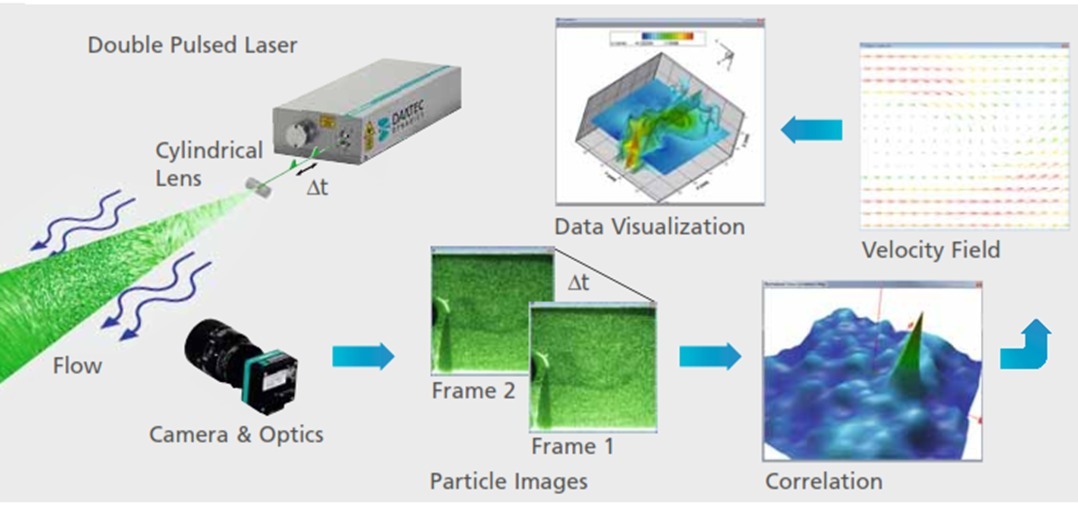Particle Image Velocimetry (PIV) is a whole-flow-field technique providing instantaneous velocity vector measurements in a cross-section of a flow. Two velocity components are measured, but use of a stereoscopic approach permits all three velocity components to be recorded, resulting in instantaneous 3D velocity vectors for the whole area.
Flow and turbulence, microfluidics, spray atomization, and combustion processes can be studied using particle image velocimetry (PIV), which is a non-intrusive laser optical measurement technique.

Recent advances in global optical diagnostic techniques, such as Particle Image Velocimetry or PIV, offer great advantages in flow measurement such as accuracy, non-intrusiveness, global nature, real-time, high spatial resolution etc.
PIV has been applied to a wide range of flow problems, varying from the flow over an aircraft wing in a wind tunnel to vortex formation in prosthetic heart valves. 3-Dimensional techniques have been sought to analyze turbulent flow and jets.
Rudimentary PIV algorithms based on cross-correlation can be implemented in a matter of hours, while more sophisticated algorithms may require a significant investment of time. Several open-source implementations are available. Application of PIV in the US education system has been limited due to high price and safety concerns of industrial research grade PIV systems.
PIV measurements can be used to:
• validate CFD (Computational fluid dynamics) predictions
• optimize stirred tank design via guiding the process of selecting tank geometry in addition to type, size, placement location and rotational speed of impellers
• select the optimal location of fluid addition or removal in both batch or continuously operated stirred tanks
Particle Image Velocimetry (PIV) is a whole-flow-field technique providing instantaneous velocity vector measurements in a cross-section of a flow. Two velocity components are measured, but use of a stereoscopic approach permits all three velocity components to be recorded, resulting in instantaneous 3D velocity vectors for the whole area.
Flow and turbulence, microfluidics, spray atomization, and combustion processes can be studied using particle image velocimetry (PIV), which is a non-intrusive laser optical measurement technique.
There has been a recent focus on investigating flows existing within viscous stirred tank systems, both experimentally and computationally, which has emphasized the high complexity and always three-dimensional nature of viscous stirred tank flows. To investigate and validate CFD code predictions of such flows, global measurement techniques are needed. Till now majority of previous experimental techniques used in investigating similar flows were either intrusive (pitot tubes, thermal probes), point (LDA), or qualitative (flow visualization techniques).
The PIV solutions from Dantec Dynamics are suitable for a wide range of research needs. Using a single camera, basic systems measure two velocity components in a plane at the same time. Advanced Systems with multiple cameras can measure three elements of velocity, either in a plane or in a volume.
Vortices can be studied with high-speed systems. Additionally, advanced features like uncertainty estimation and propagation, advanced post-processing routing for vortex detections, combined PIV / LIF / Shadow measurements, and pressure computations give you the most out of your data.
Features
• The technique is non-intrusive and measures the velocities of micron-sized particles following the flow.
• Velocity range from zero to supersonic.
• Instantaneous velocity vector maps in a cross-section of the flow.
• All three components may be obtained with the use of a stereoscopic arrangement.
• With sequences of velocity vector maps, statistics, spatial correlations, and other relevant data are available.
Results are similar to computational fluid dynamics, i.e. large eddy simulations, and real-time velocity maps are an invaluable tool for fluid dynamics researchers.
Recently, Dantec Dynamics launched its new EduStereoPIV system, extending the Edu line. It is a logical next step for teaching and training stereo PIV. The system can be added to existing EduPIV systems or used as a stand-alone unit.
Students can safely and affordably learn planar and stereo PIV techniques with EduPIV’s turnkey solution. They combine excellent reliability and performance with eye-safe LED illumination. A complete set of hardware and software, the EduPIV systems enable you to conduct table-top PIV and Stereo PIV experiments without the need for additional equipment.
0 Comments